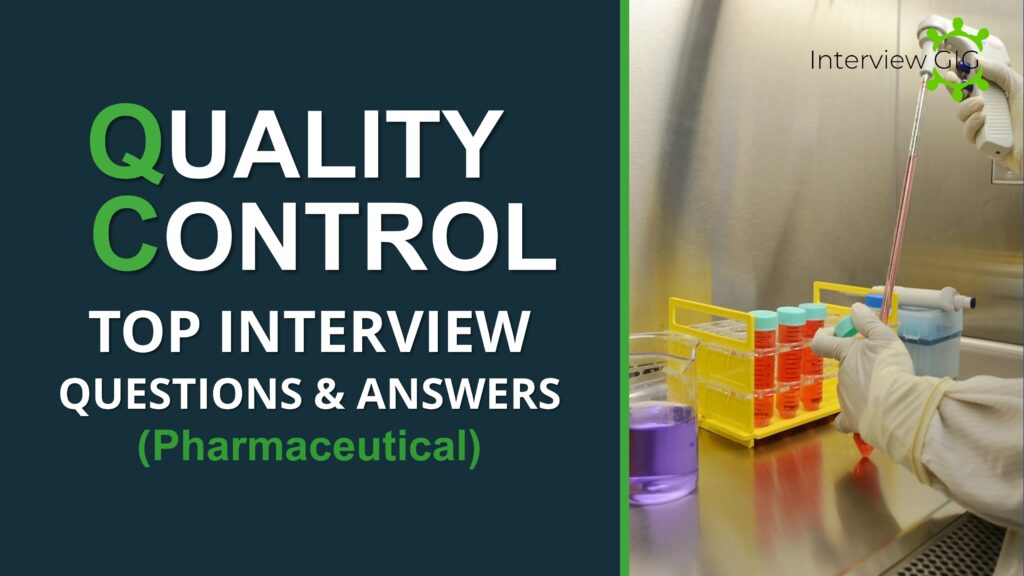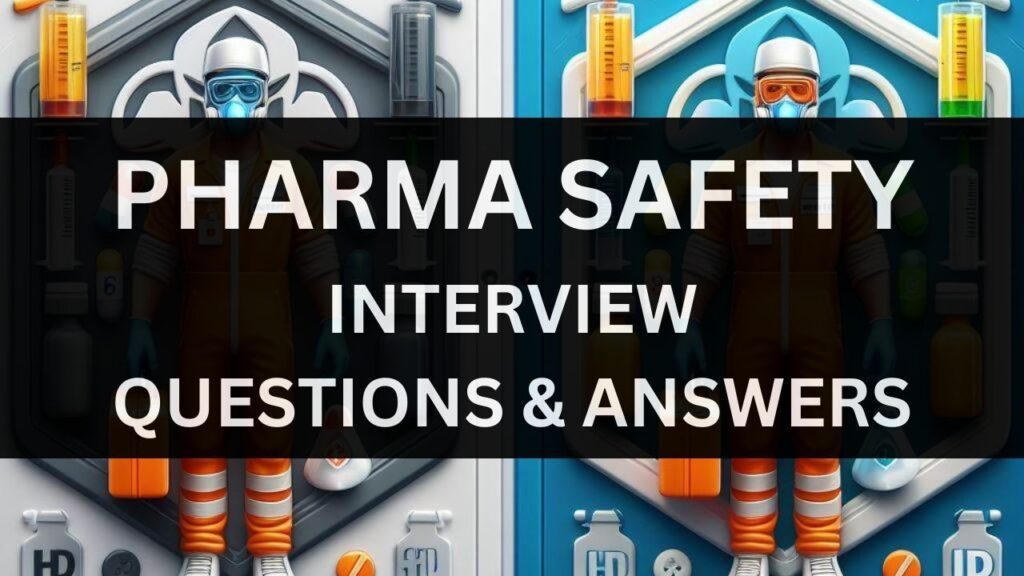Pharmaceutical Production :
The pharmaceutical production department is a vital component within pharmaceutical companies, responsible for the manufacturing and assembly of pharmaceutical products. This department operates under stringent regulations to ensure product safety, efficacy, and adherence to quality standards. It encompasses various stages, including formulation development, production planning, manufacturing processes, and quality control measures.
The department’s primary goal is to produce pharmaceutical products that meet regulatory requirements while maintaining efficiency and consistency in production processes. Through innovative technologies and stringent quality assurance protocols, pharmaceutical production departments play a critical role in delivering safe and effective medications to patients worldwide.
Top Pharma Interview Questions and Answers for Production
Question 1: Can you explain the basics of pharmaceutical production processes?
Answer: Pharmaceutical production involves stages such as raw material selection, formulation development, compounding, granulation, compression, coating, and packaging. These processes ensure the production of high-quality and safe pharmaceutical products.
Question 2: What is the significance of Good Manufacturing Practices (GMP) in pharmaceutical production?
Answer: GMP ensures that pharmaceutical products are consistently produced and controlled according to quality standards. Adhering to GMP guidelines is crucial for maintaining product quality, safety, and efficacy throughout the production process.
Question 3: How do you ensure the cleanliness and sterility of production equipment?
Answer: Regular cleaning, sterilization, and validation of equipment are essential. Implementing Standard Operating Procedures (SOPs) and following cleaning protocols help maintain a sterile and contamination-free production environment.
Question 4: Explain the concept of batch manufacturing in pharmaceutical production.
Answer: Batch manufacturing involves producing a specific quantity of a drug product, ensuring uniformity and consistency within that batch. Each batch is assigned a unique identifier and undergoes quality control testing before release.
Question 5: What is the role of Quality Control in pharmaceutical production?
Answer: Quality Control ensures that the products meet predefined quality standards. It involves testing raw materials, in-process samples, and finished products to ensure they comply with specifications and regulations.
Question 6: How do you handle deviations or unexpected issues during the production process?
Answer: I would immediately document the deviation, investigate the root cause, and implement corrective actions. Communication with the relevant stakeholders is crucial to address and prevent similar issues in the future.
Question 7: Can you explain the importance of Standard Operating Procedures (SOPs) in pharmaceutical production?
Answer: SOPs are critical for maintaining consistency, reliability, and compliance in production processes. They provide step-by-step instructions to ensure that tasks are performed correctly, reducing the risk of errors and ensuring product quality.
Question 8: What are the critical parameters in tablet compression?
Answer: Critical parameters in tablet compression include the compression force, tablet hardness, granule size and distribution, and blend uniformity. Monitoring and controlling these parameters are essential for producing tablets with the desired quality attributes.
Question 9: How do you handle equipment calibration in pharmaceutical production?
Answer: Regular calibration of production equipment is essential to ensure accuracy and reliability. I would follow the company’s calibration schedule, document the calibration process, and take corrective actions if deviations are detected.
Question 10: What safety precautions should be taken in pharmaceutical production?
Answer: Safety is paramount in pharmaceutical production. This includes wearing appropriate personal protective equipment (PPE), following safety protocols, and participating in ongoing safety training. Regular equipment maintenance and ensuring a clean and organized workspace also contribute to a safe production environment.
Question 11: What type of water is used in the manufacturing process?
Answer: In the manufacturing process, water with high purity, typically purified water (PW) or water for injection (WFI), is commonly used to meet the stringent quality requirements for pharmaceutical production.
Question 12: When do you change the water in a hygrometer?
Answer: The water in a hygrometer should be changed regularly, typically during the calibration process or when the hygrometer readings are inconsistent. Regular maintenance ensures accurate humidity measurements, crucial for maintaining optimal manufacturing conditions.
Question 13: How is material added to the mixer after completing the shifting process?
Answer: Following the completion of the shifting process, material is added to the mixer in a controlled manner to ensure uniform blending. This is achieved by gradually introducing the pre-weighed material into the mixer while it is in operation, ensuring homogeneity in the final product.
Question 14: What is the recommended percentage of IPA for cleaning machines and equipment?
Answer: The percentage of Isopropyl Alcohol (IPA) for cleaning machines and equipment is typically determined by standard operating procedures (SOPs) and industry guidelines. Generally, a concentration of 70% to 90% IPA is commonly used for effective equipment cleaning in pharmaceutical manufacturing.
Question 15: Why is it necessary to destroy the tablets during the initial rotations before starting the compression of a batch?
Answer: Destroying the tablets during the initial rotations before starting the compression of a batch is a quality control measure. It helps remove any impurities or residue from the machine surfaces, ensuring that the tablets produced afterward meet the required quality standards and do not contain contaminants from previous runs.
Question 16: What is the concept of production in the pharmaceutical industry?
Answer: Production in the pharmaceutical industry refers to the process of manufacturing pharmaceutical products on a large scale. It involves the conversion of raw materials and active ingredients into finished dosage forms through various manufacturing processes.
Question 17: Define BMR in pharmaceutical manufacturing.
Answer: BMR, or Batch Manufacturing Record, is a comprehensive document that contains all the details and instructions required for the production of a specific batch of a pharmaceutical product. It includes information on formulation, manufacturing processes, equipment used, and quality control procedures.
Question 18: Explain the significance of BPR in pharmaceutical production.
Answer: BPR, or Batch Processing Record, is a document that provides a step-by-step record of the manufacturing processes undertaken for a specific batch. It includes details such as raw material quantities, equipment used, processing conditions, and any deviations encountered during production.
Question 19: What is the definition of a tablet in pharmaceutical terms?
Answer: In pharmaceutical terms, a tablet is a solid dosage form containing medicinal substances. It is typically composed of active pharmaceutical ingredients (APIs) and excipients compressed or molded into a specific shape for easy administration and accurate dosing.
Question 20: Enumerate the methods commonly used in tablet manufacturing.
Answer: Tablet manufacturing methods include direct compression, wet granulation, dry granulation (slugging and roller compaction), and effervescent tablet production. Each method has its advantages and is chosen based on the characteristics of the drug formulation.
Question 21: Define gravitation in the context of pharmaceutical manufacturing.
Answer: Gravitation, in pharmaceutical manufacturing, refers to the settling or movement of particles or powder under the influence of gravity. It is a critical consideration in processes such as blending and granulation.
Question 22: Outline the steps involved in the granulation process.
Answer: Granulation involves several steps, including dry mixing of powders, wet massing, screening, drying, and sizing. These steps are crucial for improving the flow properties of powders, enhancing compressibility, and ensuring uniform tablet weight.
Question 23: Differentiate between direct compression and wet (or wet) granulation.
Answer: Direct compression involves directly compressing a blend of active ingredients and excipients into tablets without prior granulation. On the other hand, wet granulation includes wetting the powder blend, forming granules, drying, and then compressing into tablets. Direct compression is often preferred for formulations with good flow properties.
Question 24: What is utilized during the milling process in pharmaceutical manufacturing?
Answer: Milling in pharmaceutical manufacturing involves using equipment such as a mill or grinder to reduce the particle size of raw materials or granules. This process is crucial for achieving uniformity in particle size distribution.
Question 25: Discuss the recommended direction of knife movement for obtaining more granules in a Multi-Mill during milling.
Answer: For obtaining more granules in a Multi-Mill during milling, the knife movement should be in the radial direction. This promotes efficient granulation by facilitating the breakage of oversized particles and improving the overall granule size distribution.
Question 26: How many variable speeds does a Multi-Mill have?
Answer: A Multi-Mill typically has multiple variable speeds, allowing operators to adjust the milling speed based on the characteristics of the material being processed and the desired particle size.
Question 27: How is the feed to a Multi-Mill controlled?
Answer: The feed to a Multi-Mill is controlled through the adjustment of the feed hopper or feeder, regulating the rate at which raw materials are introduced into the milling chamber.
Question 28: What are the components of compression in tablet manufacturing?
Answer: Compression in tablet manufacturing involves essential components such as the die, punch, and tablet press machine. The compression process transforms granulated material into the final tablet form.
Question 29: Differentiate between upper punch and lower punch in tablet compression.
Answer: The upper punch is the component that descends from the upper part of the tablet press, while the lower punch rises from the lower part. Both punches work together to compress the granulated material into a tablet.
Question 30: Outline the stages of the compression process in tablet manufacturing.
Answer: The stages of tablet compression include pre-compression, main compression, and ejection. Pre-compression settles the granules, main compression forms the tablet, and ejection releases the finished tablet from the press.
Question 31: Why is coating performed in pharmaceutical manufacturing?
Answer: Coating is performed to enhance the appearance, stability, and taste of tablets. It also serves as a protective layer, preventing issues such as moisture absorption, chemical degradation, and unwanted interactions with the environment.
Question 32: What are the different colors used in tablet coating?
Answer: Tablet coatings come in various colors, including natural colors like titanium dioxide, as well as pigments and dyes. These colorants serve both aesthetic and functional purposes in pharmaceutical products.
Question 33: Name different types of tablet coating.
Answer: Types of tablet coating include sugar coating, film coating, enteric coating, and compression coating. Each type serves specific purposes such as taste masking, protecting against stomach acid, or providing an attractive appearance.
Tablet Coating Colors:
- Natural/Uncoated Tablets:
- Description: Tablets without any external coating.
- Purpose: Some immediate-release formulations may not require coating.
- Color: None.
- Film-Coated Tablets:
- Description: Coated with a thin film for improved appearance, taste masking, and stability.
- Purpose: Enhances aesthetics and protects against environmental factors.
- Color: Various, depending on the formulation.
- Enteric-Coated Tablets:
- Description: Coated to resist dissolution in the stomach and dissolve in the intestines.
- Purpose: Protects the drug from stomach acid or irritation.
- Color: Usually a variety of colors.
- Sugar-Coated Tablets:
- Description: Multiple layers of sugar-based coatings for aesthetic appeal.
- Purpose: Masks taste and provides an attractive appearance.
- Color: Bright and varied colors.
- Pearl-Coated Tablets:
- Description: Shiny, pearlescent coating for a distinctive appearance.
- Purpose: Aesthetic appeal and brand differentiation.
- Color: Pearl-like and can vary.
Question 34: What are some common defects associated with tablet coating?
Answer: Common coating defects include cracking, peeling, mottling, and uneven coating. These defects may arise due to issues in the coating process, formulation, or equipment.
Question 35: Define API in the context of pharmaceuticals.
Answer: API stands for Active Pharmaceutical Ingredient. It is the key component in a pharmaceutical drug responsible for its therapeutic effect. APIs undergo various processes to be formulated into finished dosage forms.
Question 36: Provide an example of a pharmaceutical API.
Answer: An example of a pharmaceutical API is aspirin (acetylsalicylic acid), which is widely used for its analgesic and anti-inflammatory properties.
Question 37: What is the purpose of the friability test in tablet manufacturing?
Answer: The friability test assesses the tablet’s ability to withstand mechanical stress during handling and transportation. It measures the percentage of weight loss after subjecting the tablets to controlled tumbling.
Question 38: Define RMG and RMH in pharmaceutical manufacturing.
Answer: RMG stands for Rapid Mixer Granulator, a high-speed mixing device used for wet granulation processes. RMH stands for Rapid Mixer Homogenizer, a similar device used for homogenizing and blending powders.
Question 39: What are binders in pharmaceutical formulations?
Answer: Binders are substances used in pharmaceutical formulations to promote cohesion and adhesion of powders, aiding in the formation of granules during the tablet manufacturing process. They help maintain the structural integrity of tablets.
Question 40: Differentiate between binders and super disintegrants in pharmaceutical formulations.
Answer: Binders promote the cohesion of powders in tablet formulations, aiding in granule formation. Super disintegrants, on the other hand, enhance the breakup of tablets into smaller particles upon contact with water, facilitating faster disintegration.
Question 41: How is isopropyl alcohol utilized in pharmaceutical manufacturing?
Answer: Isopropyl alcohol is commonly used for various purposes in pharmaceutical manufacturing, including surface disinfection, equipment cleaning, and as a solvent in the preparation of certain formulations.
Question 42: What types of tests are performed by tablets during the in-process stage?
Answer: Tablets undergo tests such as hardness testing, friability testing, disintegration testing, and thickness testing during the in-process stage to ensure quality and adherence to specifications.
Question 43: Specify the dosage forms of different types of tablets.
Answer: Different types of tablets include immediate-release tablets, extended-release tablets, chewable tablets, effervescent tablets, and sublingual or buccal tablets, each designed for specific therapeutic needs.
Types of Tablets:
- Immediate-Release Tablets:
- Description: Designed for rapid drug release.
- Purpose: Provides a quick onset of action.
- Examples: Aspirin, paracetamol.
- Extended-Release Tablets:
- Description: Offers a controlled release of the drug over an extended period.
- Purpose: Reduces the frequency of dosing.
- Examples: OxyContin, Glucophage XR.
- Chewable Tablets:
- Description: Meant to be chewed before swallowing.
- Purpose: Improved palatability for patients who have difficulty swallowing.
- Examples: Children’s vitamins.
- Effervescent Tablets:
- Description: Dissolves in water to form a fizzy solution.
- Purpose: Enhances patient compliance for those who dislike swallowing tablets.
- Examples: Alka-Seltzer.
- Buccal and Sublingual Tablets:
- Description: Placed in the cheek or under the tongue for absorption through the oral mucosa.
- Purpose: Rapid onset of action and avoids first-pass metabolism.
- Examples: Nitroglycerin tablets.
Question 44: Define disintegration time in tablet manufacturing.
Answer: Disintegration time is the period it takes for a tablet to break down into smaller particles when exposed to a specified liquid medium. It is a critical parameter ensuring the timely release of the drug for absorption.
Question 45: Enumerate the types of capsules used in pharmaceuticals.
Answer: Capsules come in two primary types: hard gelatin capsules and soft gelatin capsules. Hard capsules are typically used for dry powder formulations, while soft capsules are suitable for liquid or semi-solid formulations.
Question 46: What does HVAC stand for in pharmaceutical facilities?
Answer: HVAC stands for Heating, Ventilation, and Air Conditioning. It plays a crucial role in maintaining controlled environments within pharmaceutical facilities, ensuring optimal temperature, humidity, and air quality.
Question 47: In cleanroom classifications, what is an airlock, and what are its types and uses?
Answer: An airlock is a transitional space designed to control the entry and exit of personnel and materials while minimizing the introduction of contaminants. Types include pass-through airlocks and cascade airlocks, each serving specific purposes in maintaining cleanrooms integrity.
Question 48: Identify the different production areas in the pharmaceutical industry.
Answer: Pharmaceutical production areas include formulation development, research and development labs, manufacturing suites, quality control laboratories, packaging areas, and warehouses. Each area plays a distinct role in the overall drug manufacturing process.
Question 49: Can you briefly Explain about Disintegrants and Superdisintegrants?
Answer:
Disintegrants:
Definition: Disintegrants are substances added to pharmaceutical formulations to promote the rapid breakup or disintegration of tablets or capsules into smaller particles when they come into contact with water or other fluids.
Types of Disintegrants:
- Starch and Starch Derivatives: Commonly used as disintegrants, examples include corn starch and sodium starch glycolate.
- Modified Cellulose Derivatives: Examples include microcrystalline cellulose, sodium carboxymethyl cellulose (CMC), and hydroxypropyl cellulose.
- Ion Exchange Resins: Certain ion exchange resins, like Amberlite® IRP88, can function as disintegrants.
- Clays: Bentonite and Veegum are examples of clays employed for their disintegrant properties.
Usage: Disintegrants are crucial in solid oral dosage forms like tablets and capsules to ensure their rapid breakdown, facilitating drug dissolution and absorption in the gastrointestinal tract.
Superdisintegrants:
Definition: Superdisintegrants are a more advanced category of disintegrants known for their exceptional efficiency in rapidly breaking down tablets or capsules, often in smaller quantities compared to traditional disintegrants.
Types of Superdisintegrants:
- Crospovidone (cross-linked polyvinylpyrrolidone): It is a widely used superdisintegrant with excellent water absorption properties.
- Croscarmellose Sodium: Known for its high swelling capacity, it helps in rapid disintegration.
- Sodium Starch Glycolate: A modified starch derivative that swells rapidly and aids in tablet disintegration.
- Cross-linked Sodium Carboxymethyl Cellulose (Ac-Di-Sol): Offers enhanced disintegration capabilities.
Usage: Superdisintegrants find application in fast-dissolving tablets, orally disintegrating tablets (ODTs), and other formulations where rapid disintegration and dissolution are critical, especially for patients with difficulty swallowing traditional tablets or capsules.
Examples of Usage:
- Orally disintegrating tablets (ODTs) for pediatric or geriatric patients.
- In formulations where immediate drug release is necessary.
- For quick-dissolving or effervescent tablets.
Question 50: What are the roles and responsibilities of Pharmaceutical Production?
Answer: Common Roles and Responsibilities of Pharmaceutical Production:
- Formulation Development:
- Research and develop formulations for pharmaceutical products.
- Collaborate with research and development teams to optimize product compositions.
- Production Planning:
- Develop production schedules and plans to meet demand.
- Coordinate with other departments to ensure timely availability of raw materials.
- Manufacturing Processes:
- Oversee the manufacturing process, ensuring adherence to standard operating procedures.
- Monitor equipment and troubleshoot issues to maintain uninterrupted production.
- Quality Control:
- Implement quality control measures throughout the production process.
- Conduct regular inspections to ensure products meet regulatory and company standards.
- Compliance and Documentation:
- Ensure compliance with regulatory guidelines and industry standards.
- Maintain accurate and detailed documentation of production activities.
- Training and Supervision:
- Train production staff on procedures and safety protocols.
- Provide leadership and supervision to ensure a smooth workflow.
- Continuous Improvement:
- Identify opportunities for process improvement and efficiency.
- Implement changes to enhance production quality and reduce costs.
- Equipment Maintenance:
- Schedule and oversee routine maintenance of production equipment.
- Coordinate with maintenance teams to address any equipment malfunctions promptly.
- Safety Protocols:
- Implement and enforce safety protocols to ensure a secure working environment.
- Conduct regular safety training sessions for production staff.
- Collaboration:
- Collaborate with other departments such as research and development, quality assurance, and logistics.
- Communicate effectively to address cross-functional challenges and optimize production outcomes.
- Batch Record Review:
- Review and approve batch records to confirm compliance with specifications.
- Address deviations and take corrective actions as necessary.
- Scaling Up Production:
- Participate in scaling up production for new product launches.
- Coordinate with various teams to ensure a seamless transition during scaling processes.
Below are some useful Topics for interview questions and answers related to pharmaceuticals, covering Pharma safety , Organic Chemistry, Chemist R&D ,Pharmacist ,Quality Control, and Quality Assurance roles.
- Pharma Safety Interview Questions and Answers
- Safety Officer Interview Questions And Answers
- Quality Control Interview Questions & Answers In Pharma
- Pharmacist Interview Questions And Answers
- Chemist Interview Questions and Answers (Basics & Organic Chemistry)
- Quality Assurance Interview Questions in Pharma Industry





